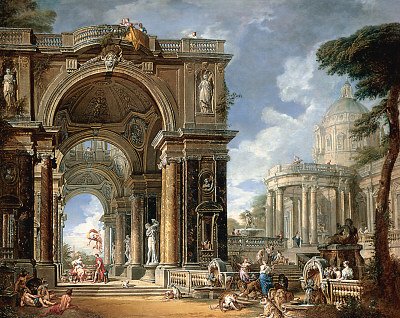 |
|
Circe entertaining Odysseus at a Banquet
Giovanni Paolo Pannini, Italian 1691 - 1765
SN 172, Oil on Canvas. About 1718-19
by Robert Anderson. 2000
Artist:
Panini is best known for his paintings of Rome's antiquities. His vedute ( accurate
landscape paintings) focused on Rome's Classical past. Ceremonies and festivals are often
featured in his paintings which thus relate a documentation of contemporary topography,
lifestyle and customs. By 1711 he had become the pre-eminent painter of real and imaginary
views of the city. He often worked in the so-called "gallery' genre : paintings of
hugh interiors stacked with the most famous views of Rome and constituing a kind of
imaginary museum. |
The paintings from his earliest years were of a relatively simple mold but
over the next several years his compositions became increasingly independent and
elaborate. After 1720, Panini concentrated on highly religious and legendary subjects in
vast classical architectural settings.He was documented as an architect as well as an
artist and had served on a panel of judges for architectural competitions.
Panini was also had an enviable reputation as a decorator of interiors,
painting frescos for many villas in Rome. As his reputation grew he was nominated to the
Accademia di Saint Luke where he taught perspective drawing and later served as principal.
Subject:
This painting relates the story of Odysseus' adventure on the Aegean isle where Circe
dwelt (Homer's Odyssey, Chapter 10, Lines 300 to 350). Circe was a powerful magician who
changed unwary visitors into animals - mostly swine. Ulysseus and his men landed on her
isle and a group were sent on ahead to investigate. They met Circe, were feasted heartily
and then were changed into swine at a touch of her wand. One man who escaped returned to
tell Odysseus of the situation. As Odyssues went forward to try to save his men he met
Hermes who gave him a plant to ward off the magic of Circe. Odysseus after feasting at
Circe's table used Hermes' plant and forced Circe to release his companions and practice
no future harm against him or them.
The men were restored to their shapes and the whole crew was entertained
magnificently. Circe then aided their departure and instructed them how to pass safely by
the coast of the sirens.
Painting:
Circe is seen entertaining Odysseus at a banquet in her sumptuous palace. Above the
traveller's head floats Hermes. In the foreground are the companions of Odysseus, already
turned into swine while on the terraces the servants of Circe as well as lions, tigers,
bears, dogs and other animals - former bewitched visitors - appear.
Painted early in his career, this painting shows a level of
experimentation for the young artist and a level of inspiration not often found in his
later works. The painting features illusionistic architecture in the monumental palace of
Circe, which provides a grandiose architectural background for the banquet of Circe &
Odysseus.The painting is also notable for its fresh color and liquid brushwork, which are
fully rococo in flavor.
Historical Context:
Rococo art was a lighter and more artificial version of the baroque and was associated
with the reign of Louis XV in France. More identified in the decorative arts than in
painting or architercture it is typified by asymmetry and the use of florid S-curves and
C-scrolls. It's subject matter was usually that of transformation and therefore a suitable
style particularly for the Circe entertaining Odysseus painting.
Paintings such as these with monumental and classical architecture
settings were heavily in demand by contemporary tourists visiting Rome as they included
views of actual or imagined monuments of ancient Rome.
|
